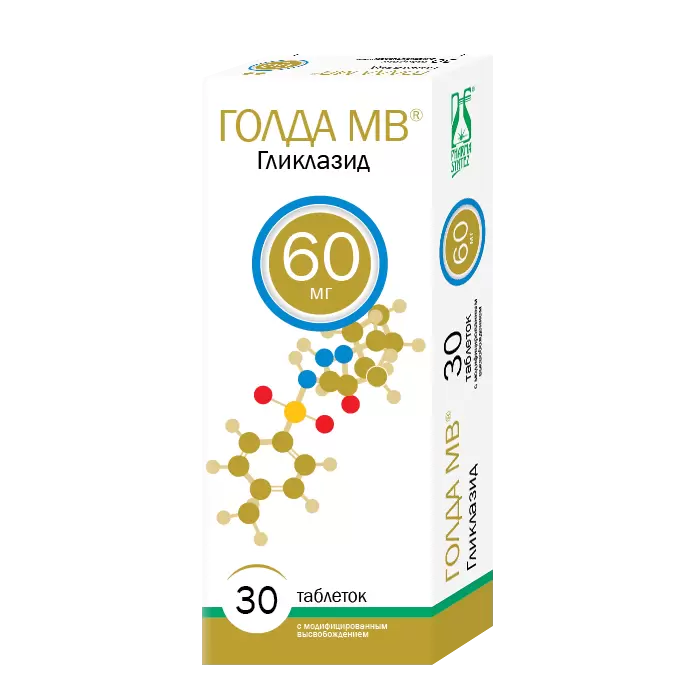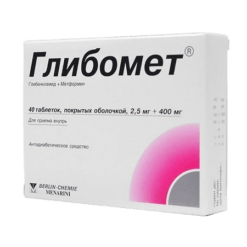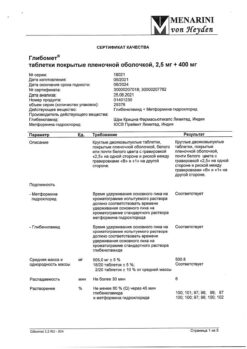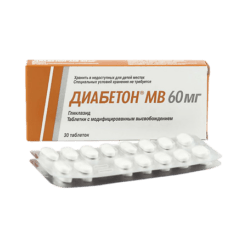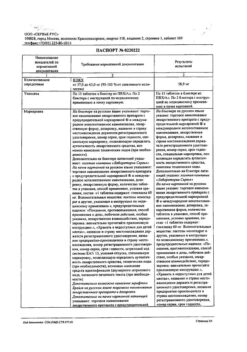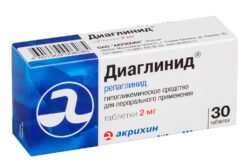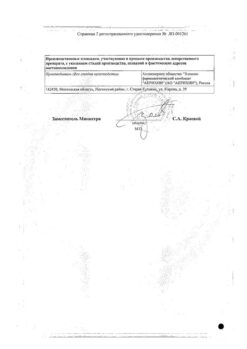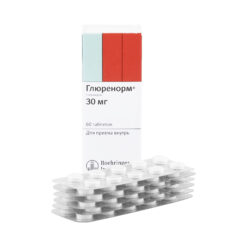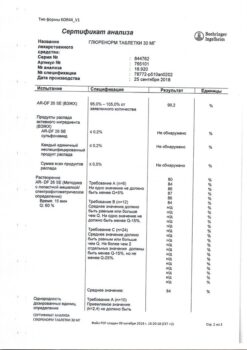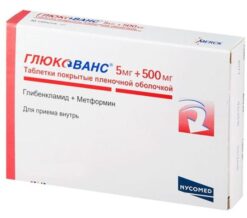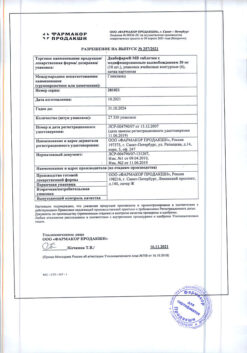No products in the cart.
Golda CF, 60 mg 30 pcs.
€6.11 €5.35
Description
Oral hypoglycemic agent of the sulfonylurea group II generation
Indications
Indications
• Type 2 diabetes mellitus with insufficient effectiveness of diet therapy, physical activity and weight loss.
• Prevention of diabetes complications: reducing the risk of microvascular (nephropathy, retinopathy) and macrovascular complications (myocardial infarction, stroke) in patients with type 2 diabetes through intensive glycemic control.
Pharmacological effect
Pharmacological effect
Hypoglycemic agent for oral use of the sulfonylurea group of the second generation
Active ingredient
Active ingredient
Gliclazide
Composition
Composition
1 tablet contains:
Active ingredient:
Gliclazide 60 mg
Excipients:
lactose monohydrate 94.0 mg;
hypromellose 140.0 mg;
sodium carboxymethyl starch type C 10.0 mg/20.0 mg;
magnesium stearate 4.0 mg;
colloidal silicon dioxide 2.0 mg.
Contraindications
Contraindications
• hypersensitivity to gliclazide, other sulfonylurea derivatives, sulfonamides or excipients included in the drug;
• diabetes mellitus type 1;
• diabetic ketoacidosis, diabetic precoma, diabetic coma;
• severe renal or liver failure (in these cases it is recommended to use insulin);
• taking miconazole (see section “Interaction with other drugs”);
• pregnancy and breastfeeding (see section “Use during pregnancy and breastfeeding”);
• age up to 18 years.
Due to the fact that the drug contains lactose, gliclazide is not recommended for patients with congenital lactose intolerance, galactosemia, and glucose-galactose malabsorption.
It is not recommended to use in combination with phenylbutazone or danazol.
With caution
Elderly patients, irregular and/or unbalanced diet, glucose-6-phosphate dehydrogenase deficiency, severe diseases of the cardiovascular system, hypothyroidism, adrenal or pituitary insufficiency, renal and/or liver failure, long-term therapy with glucocorticosteroids (GCS), alcoholism.
Side Effects
Side Effects
Given the experience with the use of gliclazide and other sulfonylurea derivatives, one should be aware of the possibility of developing the following side effects.
Hypoglycemia
Like other sulfonylureas, gliclazide can cause hypoglycemia if meals are not taken regularly and especially if meals are skipped.
Other side effects:
From the gastrointestinal tract,
from the skin and subcutaneous tissues,
from the circulatory and lymphatic system,
from the liver and biliary tract,
from the organ of vision, side effects,
inherent in sulfonylurea derivatives.
Interaction
Interaction
Drugs that increase the risk of hypoglycemia (increasing the effect of gliclazide)
Contraindicated combinations
Miconazole (with systemic administration and when using the gel on the oral mucosa): enhances the hypoglycemic effect of gliclazide (possible development of hypoglycemia up to the state of coma).
Not recommended combinations
Phenylbutazone (systemic administration): enhances the hypoglycemic effect of sulfonylurea derivatives (displaces them from binding to plasma proteins and/or slows down their elimination from the body).
It is preferable to use another anti-inflammatory drug. If taking phenylbutazone is necessary, the patient should be warned about the need for glycemic control. If necessary, the dose of gliclazide should be adjusted while taking phenylbutazone and after it is stopped.
Ethanol: increases hypoglycemia by inhibiting compensatory reactions and can contribute to the development of hypoglycemic coma. It is necessary to stop taking medications that contain ethanol and drinking alcohol.
Combinations requiring precautions
Taking gliclazide in combination with certain drugs (for example, other hypoglycemic agents (insulin, acarbose, metformin, thiazolidinediones, dipeptidyl peptidase-4 inhibitors, glucagon-like peptide-1 (GLP-1) receptor agonists), beta-blockers, fluconazole, angiotensin-converting enzyme inhibitors (captopril, enalapril), H2-histamine receptor blockers, monoamine oxidase inhibitors, sulfonamides, clarithromycin and non-steroidal anti-inflammatory drugs are accompanied by an increased hypoglycemic effect and the risk of developing hypoglycemia.
Drugs that increase blood glucose concentrations (weakening the effect of gliclazide)
Not recommended combinations
Danazol: has a diabetogenic effect. If taking this drug is necessary, the patient is advised to carefully monitor blood glucose. If it is necessary to take drugs together, it is recommended to select the dose of a hypoglycemic agent both while taking danazol and after its withdrawal.
Combinations requiring precautions
Chlorpromazine (antipsychotic): in high doses (more than 100 mg per day) increases blood glucose concentrations, reducing insulin secretion. Careful glycemic control is recommended. If it is necessary to take drugs together, it is recommended to select the dose of a hypoglycemic agent, both while taking the antipsychotic and after its withdrawal.
GCS (systemic and local use: intra-articular, external, rectal administration) and tetracosactide: increase blood glucose concentrations with the possible development of ketoacidosis (decreased tolerance to carbohydrates).
Careful glycemic control is recommended, especially at the beginning of treatment. If necessary, joint
taking medications, it may be necessary to adjust the dose of the hypoglycemic agent both while taking GCS and
after their cancellation.
Ritodrine, salbutamol, terbutaline (intravenous administration): beta-2 adrenergic agonists increase blood glucose concentrations.
Particular attention should be paid to the importance of self-glycemic control. If necessary, it is recommended to transfer the patient to insulin therapy.
Combinations to be taken into account
Anticoagulants (for example, warfarin): sulfonylureas may enhance the effect of anticoagulants when taken together. Anticoagulant dose adjustment may be required.
Overdose
Overdose
An overdose of sulfonylurea derivatives may cause hypoglycemia.
If moderate symptoms of hypoglycemia occur without impairment of consciousness or neurological symptoms, increase the intake of carbohydrates from food, reduce the dose of the drug and/or change the diet. Close medical monitoring of the patient’s condition should continue until it is certain that nothing threatens his health.
Severe hypoglycemic conditions may develop, accompanied by coma, convulsions or other neurological disorders. If such symptoms appear, emergency medical care and immediate hospitalization are necessary.
In case of hypoglycemic coma or if it is suspected, the patient is injected intravenously with 50 ml of a 20-30% dextrose (glucose) solution. Then a 10% dextrose solution is administered intravenously to maintain the blood glucose concentration above 1 g/l. Careful monitoring of blood glucose concentrations and monitoring of the patient must be carried out for at least the next 48 hours. After this period of time, depending on the patient’s condition, the attending physician decides on the need for further observation.
Dialysis is ineffective due to the pronounced binding of gliclazide to plasma proteins.
Storage conditions
Storage conditions
In the manufacturer’s original packaging at a temperature not exceeding 25 °C.
Keep out of the reach of children.
Shelf life
Shelf life
2 years. Do not use the drug after the expiration date.
Manufacturer
Manufacturer
Farmasintez-Tyumen, Russia
Additional information
| Shelf life | 2 years. Do not use the drug after the expiration date. |
|---|---|
| Conditions of storage | In the original manufacturer's package at a temperature not exceeding 25 ° C. Store out of the reach of children. |
| Manufacturer | Pharmasintez-Tyumen, Russia |
| Medication form | controlled release tablets |
| Brand | Pharmasintez-Tyumen |
Related products
Buy Golda CF, 60 mg 30 pcs. with delivery to USA, UK, Europe and over 120 other countries.

